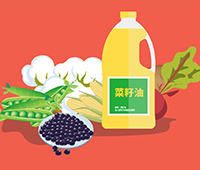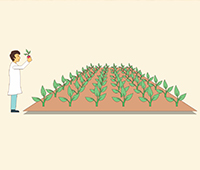近日,华中农业大学果蔬园艺作物种质创新与利用全国重点实验室、华中农业大学园艺林学学院桃课题小组研究成果以“Two interacting ethylene response factors negatively regulate peach resistance to Lasiodiplodia theobromae”为题在Plant Physiology发表。研究揭示了乙烯响应因子PpERF98和PpERF1相互作用调控桃树响应流胶病菌侵染的分子机制,为桃树的抗病分子育种提供了重要的基因资源。
流胶病是桃树栽培过程中常见的主要病害之一,多发生于我国长江流域及其以南的高温高湿地区。该病主要危害桃树的主干、主枝等部位,造成组织坏死并伴随大量胶体外溢,导致树势衰弱、果实产量和品质下降,严重影响桃的经济价值。葡萄座腔菌科(Botryosphaeriaceae)真菌可可毛色二孢(L. theobromae)是一种强致病力的半活体营养型真菌,是引起桃流胶病的主要致病菌之一,也可引起葡萄和杨树溃疡病、苹果轮纹病以及茶树叶斑病等。
课题组前期研究结果表明外源乙烯和茉莉酸甲酯增加桃对流胶病菌L. theobromae的敏感性,而水杨酸增加桃的抗性(Zhang et al., 2021, Horticulture Research),但是其分子机制尚不明晰。作者对接种L. theobromae的桃枝条进行转录组和基因表达分析,发现与拟南芥ERF98同源的两个基因PpERF98-1和PpERF98-2受流胶病菌和外源乙烯处理显著诱导,且在流胶病敏感的桃品种中转录水平更高。为了探究PpERF98在桃应答流胶病菌中的作用和调控网络,对PpERF98-1/2沉默和过表达桃苗和番茄植株的抗性分析,证实了这两个转录因子负调控桃对L. theobromae的抗性。进一步发现PpERF98-1和PpERF98-2可以自身形成同源二聚体或相互作用形成异源二聚体,结合到茉莉酸/乙烯信号通路上的关键转录因子PpERF1的启动子上并激活其表达;同时PpERF98-1/2也可以与PpERF1蛋白形成异源二聚体共同介导茉莉酸/乙烯信号通路的ERF分支,最终削弱水杨酸依赖的抗病防御反应。本研究揭示了乙烯基于PpERF98-PpERF1转录级联参与调控桃对L. theobromae易感性的分子机制,为桃的抗病分子育种提供了重要的可编辑基因和靶点。
果蔬园艺作物种质创新与利用全国重点实验室、我校园艺林学学院博士后张东梅为论文第一作者,刘军伟副研究员为该论文的通讯作者。华中农业大学李国怀教授和刘继红教授、意大利都灵大学Francesca Cardinale教授参与并指导了这项研究工作。本研究得到了国家自然科学基金(32202410和32172516)、国家现代桃产业技术体系(CARS-30)的经费资助。
【英文摘要】
Gummosis is one of the most common and destructive diseases threatening global peach (Prunus persica) production. Our previous studies have revealed that ethylene and methyl-jasmonate enhance peach susceptibility to Lasiodiplodia theobromae, a virulent pathogen inducing gummosis; however, the underlying molecular mechanisms remain obscure. Here, two ethylene response factors, PpERF98 and PpERF1, were identified as negative regulators in peach response to L. theobromae infection. expression of two putative paralogs, PpERF98-1/2, was dramatically induced by ethylene and L. theobromae treatments and accumulated highly in the gummosis-sensitive cultivar. Silencing of PpERF98-1/2 increased salicylic acid (SA) content and pathogenesis-related genes PpPR1 and PpPR2 transcripts, conferring peach resistance to L. theobromae, whereas peach and tomato (Solanum lycopersicum) plants overexpressing either of PpERF98-1/2 showed opposite changes. Also, jasmonic acid markedly accumulated in PpERF98-1/2-silenced plants, but reduction in PpPR3, PpPR4, and PpCHI (Chitinase) transcripts indicated a blocked signaling pathway. PpERF98-1/2 were further demonstrated to directly bind the promoters of two putative paralogous PpERF1 genes and to activate the ERF branch of the jasmonate/ethylene signaling pathway, thus attenuating SA-dependent defenses. The lesion phenotypes of peach seedlings overexpressing PpERF1-1/2 and PpERF98-1/2 were similar. Furthermore, PpERF98-1/2 formed homo-/hetero-dimers and interacted with the two PpERF1 proteins to amplify the jasmonate/ethylene signaling pathway, as larger lesions were observed in peach plants co-overexpressing PpERF98 with PpERF1 relative to individual PpERF98 overexpression. Overall, our work deciphers an important regulatory network of ethylene-mediated peach susceptibility to L. theobromae based on a PpERF98-PpERF1 transcriptional cascade, which could be utilized as a potential target for genetic engineering to augment protection against L. theobromae-mediated diseases in crops and trees.
论文链接:https://academic.oup.com/plphys/advance-article/doi/10.1093/plphys/ kiad279/715981 4?searchresult=1







